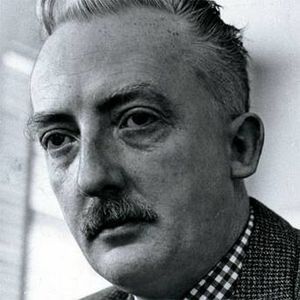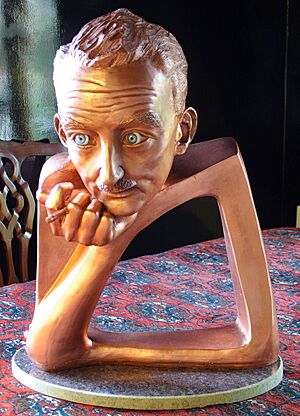Seán Ó Riada facts for kids
Quick facts for kids
Seán Ó Riada
|
|
|---|---|
 |
|
| Background information | |
| Birth name | John Reidy |
| Born | 1 August 1931 Cork, Ireland |
| Died | 3 October 1971 (aged 40) London, United Kingdom |
| Occupation(s) | Composer |
| Years active | 1954–1971 |
Seán Ó Riada (born John Reidy; 1 August 1931 – 3 October 1971) was an Irish composer and arranger. He is famous for bringing Irish traditional music back to life in the 1960s. He mixed old Irish music styles with new ideas, making him a very important person in Irish music history.
Seán Ó Riada started his career in 1954 as a music director at Radio Éireann. Later, he worked at the Abbey Theatre from 1955 to 1962. From 1963 until he passed away in 1971, he taught music at University College Cork. He became well-known in Ireland because of his work with the music group Ceoltóirí Chualann, his own music, and his radio shows.
He wrote famous film scores like Mise Éire (1959) and Saoirse? (1960). He also started and led the group Ceoltóirí Chualann from 1961. Even today, his music is still loved. For example, his Mass in Irish is still sung in many churches in Irish-speaking areas of Ireland. Seán Ó Riada died in 1971, just after his 40th birthday.
| Top - 0-9 A B C D E F G H I J K L M N O P Q R S T U V W X Y Z |
Early Life and Music Journey
Seán Ó Riada was born John Reidy in Cork City. He spent his early years in Adare, County Limerick, where his father, a police sergeant, was based. He went to school in Adare and later at St Finbarr's College, Farranferris. There, he learned a lot about music from Aloys Fleischmann (Senior). He finished high school at St Munchin's College in Limerick in 1948.
He was very talented and played the violin, piano, and organ. He also studied Greek and Latin at University College Cork, graduating in 1952. After college, he became an assistant director for Radio Éireann. In 1953, he married Ruth Coughlan.
In the evenings, he played piano with dance bands. In 1955, Ó Riada spent several months in France. This trip helped him become more interested in modern music styles. When he returned, he became the music director for the Abbey Theatre, Dublin. He wrote and arranged music for the theatre's orchestra and continued his radio work. During this time, he also wrote many of his own orchestral pieces.
Mise Éire: A Famous Film Score
Ó Riada wrote and directed music for plays and films. He often mixed traditional Irish tunes and "sean-nós" (old style) songs with classical music. This was similar to how other composers, like Dvořák and Bartók, used their own country's folk music in their classical works.
In 1959, he wrote the music for a documentary film called Mise Éire ("I am Ireland"). The film was about the start of the Irish Republic. Ó Riada himself conducted the music for the film. Mise Éire made him very famous across Ireland. It also led to him hosting a radio show called Our Musical Heritage. On his show, Ó Riada encouraged people to listen to sean-nós singing with an open mind, like a child would, or as if the songs came from a faraway place like India.
Ceoltóirí Chualann: A New Sound
Between 1961 and 1969, Seán Ó Riada led a group called Ceoltóirí Chualann. They performed in concert halls, dressed in black suits and white shirts, but they played traditional Irish songs and tunes. Unlike other bands, Ceoltóirí Chualann played their music in a clear, simple way.
Ó Riada sat in the middle, playing a harpsichord and a bodhrán. The bodhrán is a hand-held drum that was not very common at the time. Most bands used jazz drum kits. Ó Riada also wanted to use the clarsach, an old Irish harp, but since they were hard to find, he used the harpsichord instead. The harpsichord he used was made by Cathal Gannon. For many people in Ireland, this was the first time they heard traditional Irish tunes played by a band in this new way. Some of the musicians in Ceoltóirí Chualann also played in another famous group called The Chieftains. The last public show by Ceoltóirí Chualann was in 1969.
Later Years and Legacy
In 1963, Ó Riada became a music lecturer at University College, Cork. He moved to Baile Bhúirne, an Irish-speaking area in West Cork. There, he started a male voice choir called Cór Chúil Aodha. He began to write church music, including two settings of the Mass. Ceol an Aifrinn ("Music of the Mass") was the first Mass written in the Irish language. This Mass includes the popular hymn "Ag Críost an Síol", which many people mistakenly think is a very old tune because it sounds so traditional.
Seán Ó Riada passed away in London in 1971 after an illness. He is buried in St Gobnait's graveyard in Baile Bhuirne, County Cork.
Lasting Influence
Seán Ó Riada and Ceoltóirí Chualann created a famous musical version of the poem Mná na hÉireann by Peadar Ó Doirnín. Many artists have recorded or used this piece. For example, the Chieftains' version is used in the movie Barry Lyndon.
Ó Riada's daughter, Liadh Ní Riada, became a politician. She was elected as a Sinn Féin Member of the European Parliament in 2014 and ran for president of Ireland in 2018.
The Irish poet Séamus Heaney wrote a poem called "In Memoriam Seán Ó Riada" in his 1979 book Field Work. In 2008, a statue of Seán Ó Riada was put up in Cúil Aodha.
In 2010, Ceoltóirí Chualann reunited under the leadership of Ó Riada's son, Peadar Ó Riada, for a tribute concert in Dublin. In 2011, a festival called Féile na Laoch (Festival of Heroes) was held in his honor. It celebrated heroes from different arts like storytelling, music, and dance.
Two schools are named 'Scoil Uí Riada' after him: one in Kilcock, County Kildare, and another in Bishopstown, Cork City.
Main Works
Seán Ó Riada wrote many different types of music. Here are some of his important works:
Opera
- Spailpín a Rúin. An opera in 3 acts (1960).
Orchestral Music
- Overture Olynthiac (1955)
- The Banks of Sulán. A calm piece for orchestra (1956)
- Nomos No. 1: Hercules Dux Ferrariae for string orchestra (1957)
- Nomos No. 4 for piano and orchestra (1958)
- Triptyche pour orchestre symphonique (1960)
Film Music
- Mise Éire (1959)
- Saoirse? (1960)
- Kennedy's Ireland (1960)
- Young Cassidy (1965)
Religious Music
- Ceol an Aifrinn / Ó Riada Mass (1968) – The first Mass written in the Irish language.
- Aifreann nua / Aifreann 2 (1970)
Recordings
Seán Ó Riada's music has been released on many recordings. Here are some of the most well-known:
Solo Recordings
- Mise Éire: Gael-Linn CEF 002 (1960). This recording features his famous film score.
- Saoirse?: Gael-Linn GL 1 (1960).
- Vertical Man: Claddagh Records CSM 1 (1969). This album includes some of his classical pieces.
- Ceol an Aifrinn / Ó Riada Mass: Gael-Linn CB 3 (1971). This is his Mass in Irish.
- Ó Riada's Farewell: Claddagh Records CC 12 (1972). This features traditional Irish music played on harpsichord.
Recordings by Ceoltóirí Chualann
- Reacaireacht an Riadaigh: Gael-Linn CEF 010 (1961).
- Ceol na nUasal: Gael-Linn CEF 015 (1967).
- ding dong: Gael-Linn CEF 016 (1967).
- Ó Riada sa Gaiety: (1971). This album is a recording of their live performance.
- Port na bPúcaí (2014). This CD includes previously unreleased recordings by Ó Riada.
Images for kids




